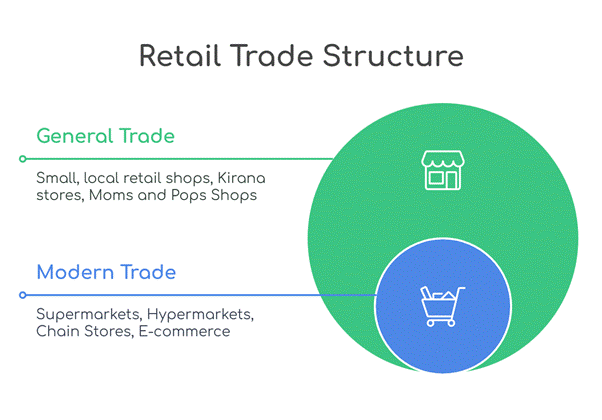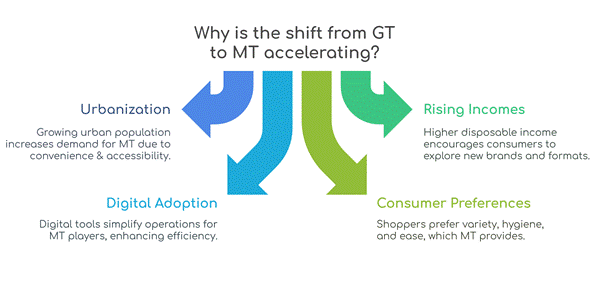Table of Contents
ToggleWelcome to India’s evolving retail battleground, where General Trade (GT) and Modern Trade (MT) continue to shape the way fast-moving consumer goods (FMCG) reach shelves and homes through innovative sales and distribution management.
Both models hold immense power. While GT dominates with deep local networks and trust, MT is gaining momentum with its scale, tech, and urban appeal. The retail market is growing by over 12% each year. Modern stores will grow faster, at 20% each year, while traditional shops will grow more slowly, at 10% each year.
For FMCG and CPG brands, decoding the strengths, limitations, and future of both channels is no longer optional; it’s imperative for long-term sustainability.
Let’s break down the what, why, and how behind these two FMCG retail models in India.
What is General Trade & Modern Trade?

General Trade (GT): General Trade refers to the local, small, unorganized retail shops around your neighborhood such as kirana store, local chemist, or mom-and-pop shop. These stores are usually run by individuals or families, and typically operate on trust, credit, and personal relationships.
Modern Trade (MT): Modern trade, on the other hand, refers to organized retail chains managed by big companies. This includes supermarkets, hypermarkets, chain stores, and even e-commerce platforms. MT offers standardized pricing, branded shelves, loyalty programs, and data-driven stocking.
Why do they matter?
In India, General Trade still holds the maximum share in retail sales (almost 70-80%) as of 2025. But Modern Trade is growing at 20–25% annually, especially in urban and Tier 2+ markets.
So if businesses want to have a pan-India presence, both are gold mines. Thus, all you need is the right strategy to tap into the strengths of General Trade and Modern Trade, ensuring your product reaches every type of consumer, from a small town to a metro city.
How the Market is Shifting in 2025?
India’s retail ecosystem is undergoing a tectonic shift, where we can expect a significant shift in both general trade and modern trade. Some of the key changes are mentioned below:

- General Trade is shrinking: From 85% in 2022 to a projected 65–70% by 2026–27.
- Modern Trade is accelerating[2] : Expected to grow from 18–20% in 2024 to 25–30% by 2025, led by urban convenience, digitization, and e-commerce.
- Investments are flowing in: The sector is set to attract $15–20 billion by 2025.
- Sustainability matters: 70% of Indian shoppers now factor sustainability into their purchase decisions.
- Tier 2 and 3 cities are rising: As per Deloitte, 60% of future retail growth will come from smaller towns – thanks to better infrastructure, higher aspirations, and growing income levels.
The bottom line? Both GT and MT are evolving, but in different ways — and brands must ride both waves smartly.
Why General Trade Still Matters for CPG/FMCG Brands

Despite being traditional, GT is far from outdated. Here’s why brands still rely on it:
- Deep Market Penetration: Kirana stores are in every nook and corner, from dense metros to remote villages. Brands like Parle or Nirma thrive on this scale.
- Trust-Based Transactions: Local retailers often offer products on credit. For low-income families, this builds trust and loyalty.
- Low Operational Costs: No big infrastructure or rent overheads. This keeps margins healthy and prices competitive.
- Community Connect: A kirana owner knows their customers personally. That kind of insight is hard to replicate in modern stores.
- Quick Stock Movement: Products move faster due to high footfall, especially during local festivals or daily essentials like milk and bread.
For Example: A biscuit brand launching a ₹5 SKU will gain faster rural traction through GT outlets rather than MT chains.
Why Modern Trade is the Future Growth Engine?

Modern Trade isn’t just about shiny stores. It’s a data goldmine.
Here’s why it matters:
- High Shelf Visibility: Brands get better product placement, in-store branding, and impulse purchases.
- Consumer Insights: POS systems offer real-time data on buying behavior, enabling smarter decisions.
- Higher ASP (Average Selling Price): MT consumers are willing to pay for premium and sustainable options.
- Cross-Selling & Promotions: Organized stores enable bundled offers, loyalty programs, and seasonal promotions.
- E-commerce Integration: Platforms like BigBasket or Blinkit blend offline logistics with online convenience.
For Example: A health-conscious yogurt brand may find more success through MT, where cold chains, awareness, and impulse trials are higher.
Why is the Shift from GT to MT Accelerating?
Several forces are driving this evolution:

- Urbanization: India’s urban population is set to hit 600 million+ by 2030.
- Rising Incomes: More disposable income means higher willingness to explore new brands and formats.
- Digital Adoption: UPI, e-invoicing, and POS are simplifying operations for MT players.
- Consumer Preferences: Shoppers prefer variety, hygiene, and ease — MT delivers on all.
But this shift is not replacing GT. It’s redefining its role.
General Trade: Challenges & How FieldAssist SFA Solves Them
| Challenges | Solution with FieldAssist |
| Low Sales Team Productivity | The smart beat planning in SFA ensures reps visit the right outlet at the right time. FA SFA suggests optimized routes, increasing daily outlet coverage, and reducing idle time. |
| Order Inaccuracy & Manual Errors | Get intelligent order suggestions, based on outlet buying patterns and scheme eligibility, to ensure accurate and fast order capture. |
| Poor Outlet Visibility | You can track outlet performance across SKUs, schemes, and order history in real time. Managers also get GPS-tagged visit reports and actionable dashboards. |
| No Real-Time Stock Intelligence | SFA collects secondary sales and stock data directly from retailers, giving reps better insight for upselling or restocking decisions. |
| Weak Scheme Execution | Digital scheme visibility at outlet level ensures that the right schemes are pitched at the right time. Instant validations minimize leakages. |
| Disconnected Field Teams | The live dashboards and field rep tracking make it easier for sales managers to coach, support, and motivate their teams daily. |
Result: 18% increase in productive calls, 13% ROI growth, and 2X faster GT market expansion.
Modern Trade: Challenges & How FA ModMart Solves Them
| Challenge | Solution with FieldAssist |
| Inconsistent SKU Availability | The stock management feature in ModMart provides real-time alerts for stockouts and validates the presence of SKUs according to each store’s plan. Thus, one can ensure new product launches or must-stock SKUs do not miss out. |
| Low Promoter Accountability | With geo-fenced, selfie-based check-ins, brand managers can validate store visits, ensure grooming, and monitor real-time attendance. |
| Planogram Non-Compliance | Using planogram compliance tracking and image recognition, brands can monitor shelf execution and take quick action on stores with low share-of-shelf. |
| Weak Campaign Tracking | Whether it’s an in-store sampling or a custom promo pack, ModMart enables account-level campaign execution, with visibility into ROI and promotional impact. |
| Unreliable Stock Audits | ModMart captures opening, inward, and closing stock each day, with validations against distributor POs, reducing human errors and improving stock accuracy. |
| Low-Quality Merchandising Execution | Track every activity with merchandiser day summary, raise stock requisitions from the app, and identify OOS products at a glance. |
| Poor In-Store Engagement | Enable promoters to influence footfall buying behavior using guided sampling, suggestive selling, and product demos. |
| Lack of Field-Level Insights | Get visual analytics on-the-go to make timely, store-specific decisions without waiting for end-of-month reviews. |
The Power of a Hybrid Retail Strategy (GT + MT = Success)
The smartest brands aren’t choosing one, they’re choosing both. A hybrid retail strategy that combines General Trade (GT) and Modern Trade (MT) gives brands the best of both worlds for tapping the unexplored markets.
Why go hybrid?
- Broader Reach. A hybrid GT + MT sales and distribution model gives brands a dual presence. Thus, making a business less dependent on one channel for wider market penetration.
- Better Data Insights. With a hybrid model, one can combine local intelligence with structured insights, giving you a comprehensive understanding of both macro-level trends and micro-level consumer preferences.
- Smarter Allocation. A hybrid model can also provide you an edge with tailor pricing, packaging, and promotions based on channel needs, allowing you to optimize revenue across different retail environments.
With FieldAssist AI-powered sales and distribution technologies, businesses get a unified platform that adapts to both GT and MT workflows, with intelligent forecasting, customizable beat plans, and role-specific dashboards.
Conclusion:
The debate between General Trade and Modern Trade for sales and distribution management excellence isn’t about which is better but more about what works best for the company’s growth in urban and rural sectors.
- Use GT for scale, trust, and last-mile coverage in rural, untapped areas of India.
- Use MT for visibility, brand-building, and data intelligence in the urban landscape of India.
And if you want to win in both? Equip your sales team with tools that help them navigate both terrains with ease and clarity. Because in the coming time, retail success in 2025 will belong to brands that think hybrid, act smart, and adapt fast.
About Post Author
Deepika Saxena
Deepika is a seasoned product marketer in B2B SaaS, helping businesses scale with data-driven strategies and impactful storytelling. When not reading up about new trends, she enjoys traveling, exploring new cuisines, and navigating the adventures of motherhood.


